Comparative Analysis: Cross-Cultural Marketing Strategies (India & UK)
VerifiedAdded on 2023/01/18
|8
|2102
|48
Report
AI Summary
This report delves into the realm of cross-cultural marketing, examining how businesses navigate the complexities of diverse cultural landscapes. It begins with an introduction to cross-cultural marketing, emphasizing the importance of understanding cultural differences to effectively market products and services. The report then critically evaluates various cultural models, including Hofstede's, Hall and Hall's, and Wills' models, highlighting their strengths and weaknesses in identifying and analyzing cultural dimensions. A significant portion of the report is dedicated to a comparative analysis of marketing strategies in India and the UK, using Hofstede's model to assess dimensions such as power distance, individualism, masculinity, uncertainty avoidance, and indulgence. The report concludes by emphasizing the relevance of these cultural models in the 21st century, particularly in the context of globalization and the need for businesses to adapt their marketing approaches to resonate with diverse consumer bases. The report highlights the impact of culture on marketing, providing insights into how cultural understanding can lead to competitive advantages and effective marketing communication.

Marketing across
Cultures (CW1)
1
Cultures (CW1)
1
Paraphrase This Document
Need a fresh take? Get an instant paraphrase of this document with our AI Paraphraser
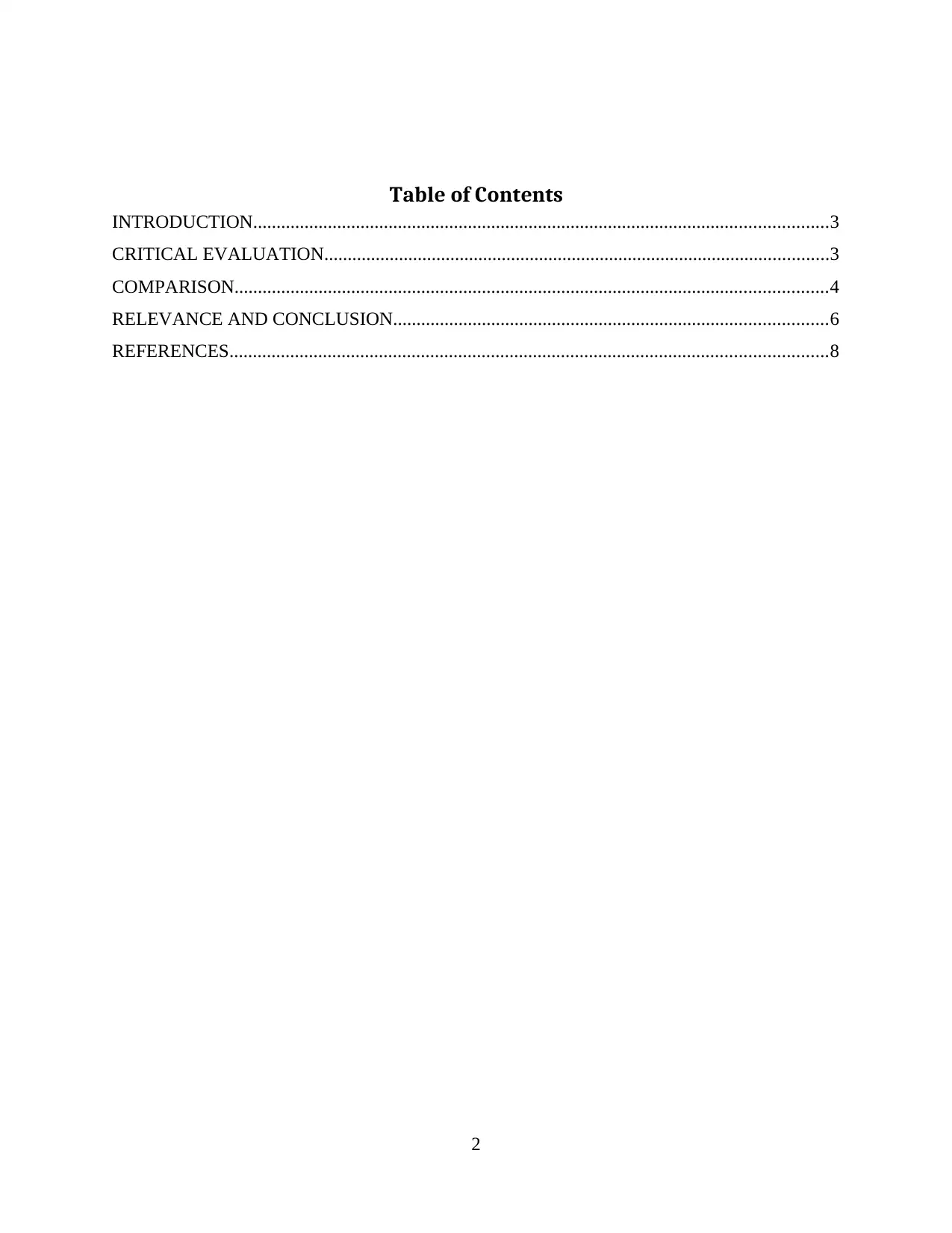
Table of Contents
INTRODUCTION...........................................................................................................................3
CRITICAL EVALUATION............................................................................................................3
COMPARISON...............................................................................................................................4
RELEVANCE AND CONCLUSION.............................................................................................6
REFERENCES................................................................................................................................8
2
INTRODUCTION...........................................................................................................................3
CRITICAL EVALUATION............................................................................................................3
COMPARISON...............................................................................................................................4
RELEVANCE AND CONCLUSION.............................................................................................6
REFERENCES................................................................................................................................8
2
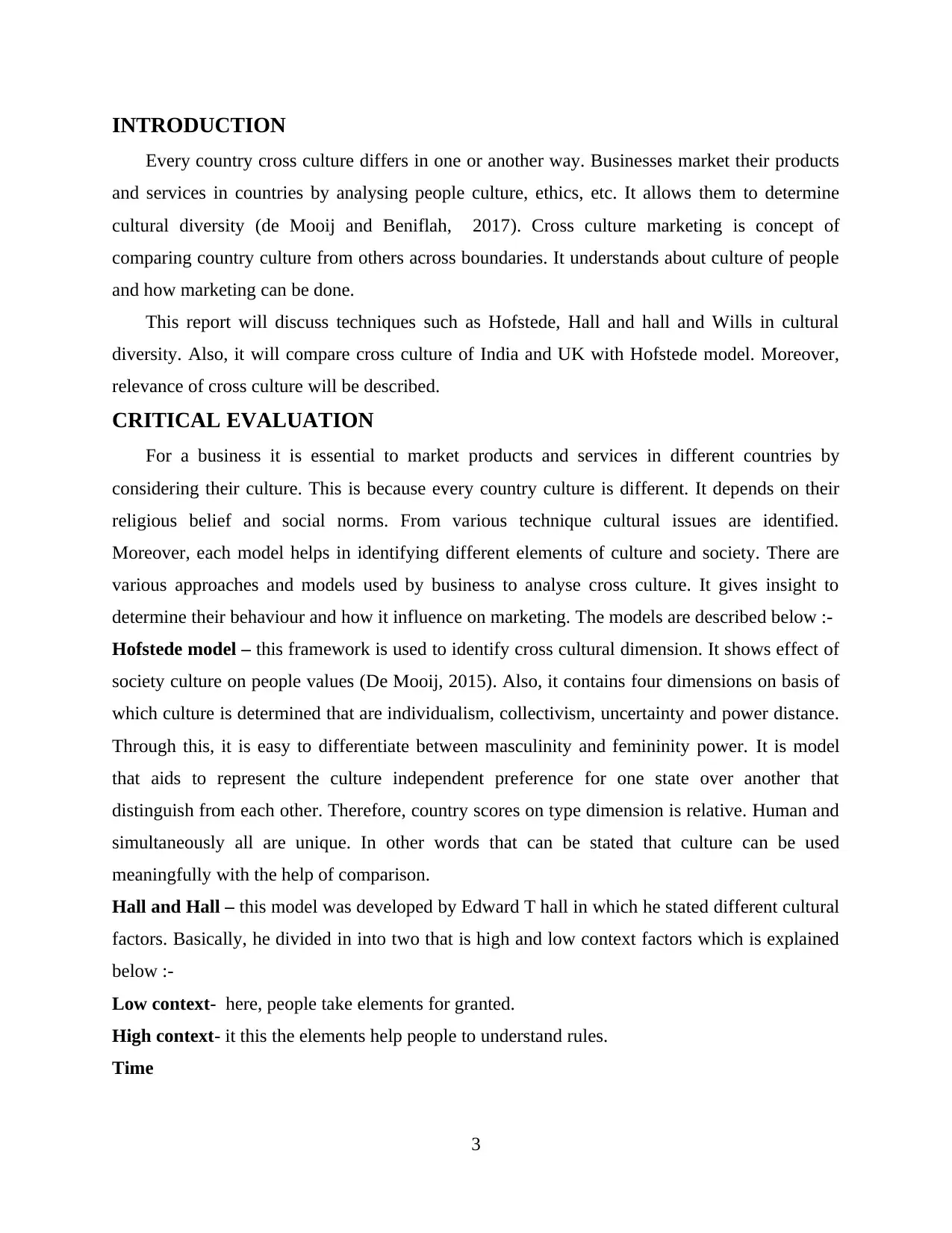
INTRODUCTION
Every country cross culture differs in one or another way. Businesses market their products
and services in countries by analysing people culture, ethics, etc. It allows them to determine
cultural diversity (de Mooij and Beniflah, 2017). Cross culture marketing is concept of
comparing country culture from others across boundaries. It understands about culture of people
and how marketing can be done.
This report will discuss techniques such as Hofstede, Hall and hall and Wills in cultural
diversity. Also, it will compare cross culture of India and UK with Hofstede model. Moreover,
relevance of cross culture will be described.
CRITICAL EVALUATION
For a business it is essential to market products and services in different countries by
considering their culture. This is because every country culture is different. It depends on their
religious belief and social norms. From various technique cultural issues are identified.
Moreover, each model helps in identifying different elements of culture and society. There are
various approaches and models used by business to analyse cross culture. It gives insight to
determine their behaviour and how it influence on marketing. The models are described below :-
Hofstede model – this framework is used to identify cross cultural dimension. It shows effect of
society culture on people values (De Mooij, 2015). Also, it contains four dimensions on basis of
which culture is determined that are individualism, collectivism, uncertainty and power distance.
Through this, it is easy to differentiate between masculinity and femininity power. It is model
that aids to represent the culture independent preference for one state over another that
distinguish from each other. Therefore, country scores on type dimension is relative. Human and
simultaneously all are unique. In other words that can be stated that culture can be used
meaningfully with the help of comparison.
Hall and Hall – this model was developed by Edward T hall in which he stated different cultural
factors. Basically, he divided in into two that is high and low context factors which is explained
below :-
Low context- here, people take elements for granted.
High context- it this the elements help people to understand rules.
Time
3
Every country cross culture differs in one or another way. Businesses market their products
and services in countries by analysing people culture, ethics, etc. It allows them to determine
cultural diversity (de Mooij and Beniflah, 2017). Cross culture marketing is concept of
comparing country culture from others across boundaries. It understands about culture of people
and how marketing can be done.
This report will discuss techniques such as Hofstede, Hall and hall and Wills in cultural
diversity. Also, it will compare cross culture of India and UK with Hofstede model. Moreover,
relevance of cross culture will be described.
CRITICAL EVALUATION
For a business it is essential to market products and services in different countries by
considering their culture. This is because every country culture is different. It depends on their
religious belief and social norms. From various technique cultural issues are identified.
Moreover, each model helps in identifying different elements of culture and society. There are
various approaches and models used by business to analyse cross culture. It gives insight to
determine their behaviour and how it influence on marketing. The models are described below :-
Hofstede model – this framework is used to identify cross cultural dimension. It shows effect of
society culture on people values (De Mooij, 2015). Also, it contains four dimensions on basis of
which culture is determined that are individualism, collectivism, uncertainty and power distance.
Through this, it is easy to differentiate between masculinity and femininity power. It is model
that aids to represent the culture independent preference for one state over another that
distinguish from each other. Therefore, country scores on type dimension is relative. Human and
simultaneously all are unique. In other words that can be stated that culture can be used
meaningfully with the help of comparison.
Hall and Hall – this model was developed by Edward T hall in which he stated different cultural
factors. Basically, he divided in into two that is high and low context factors which is explained
below :-
Low context- here, people take elements for granted.
High context- it this the elements help people to understand rules.
Time
3
⊘ This is a preview!⊘
Do you want full access?
Subscribe today to unlock all pages.

Trusted by 1+ million students worldwide
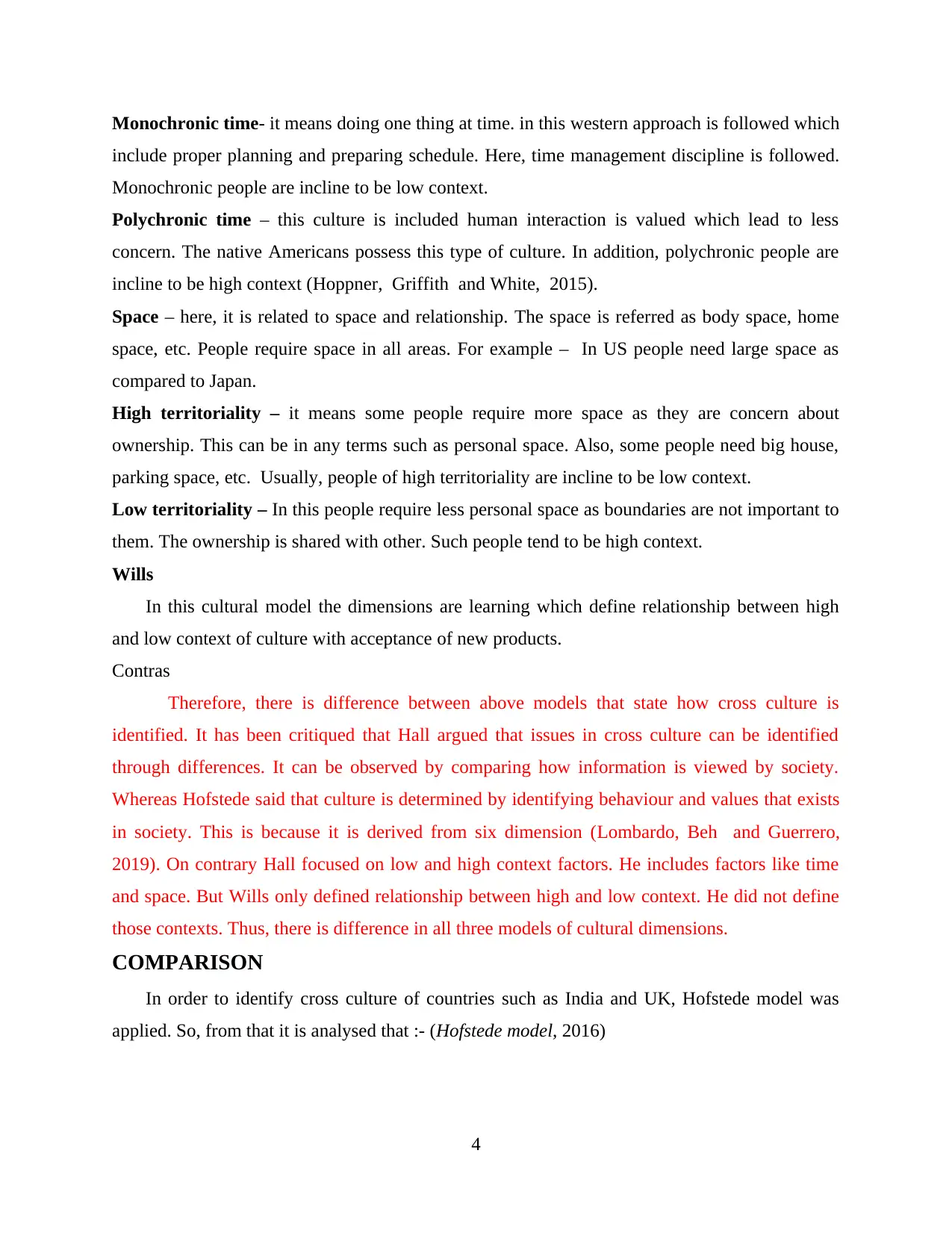
Monochronic time- it means doing one thing at time. in this western approach is followed which
include proper planning and preparing schedule. Here, time management discipline is followed.
Monochronic people are incline to be low context.
Polychronic time – this culture is included human interaction is valued which lead to less
concern. The native Americans possess this type of culture. In addition, polychronic people are
incline to be high context (Hoppner, Griffith and White, 2015).
Space – here, it is related to space and relationship. The space is referred as body space, home
space, etc. People require space in all areas. For example – In US people need large space as
compared to Japan.
High territoriality – it means some people require more space as they are concern about
ownership. This can be in any terms such as personal space. Also, some people need big house,
parking space, etc. Usually, people of high territoriality are incline to be low context.
Low territoriality – In this people require less personal space as boundaries are not important to
them. The ownership is shared with other. Such people tend to be high context.
Wills
In this cultural model the dimensions are learning which define relationship between high
and low context of culture with acceptance of new products.
Contras
Therefore, there is difference between above models that state how cross culture is
identified. It has been critiqued that Hall argued that issues in cross culture can be identified
through differences. It can be observed by comparing how information is viewed by society.
Whereas Hofstede said that culture is determined by identifying behaviour and values that exists
in society. This is because it is derived from six dimension (Lombardo, Beh and Guerrero,
2019). On contrary Hall focused on low and high context factors. He includes factors like time
and space. But Wills only defined relationship between high and low context. He did not define
those contexts. Thus, there is difference in all three models of cultural dimensions.
COMPARISON
In order to identify cross culture of countries such as India and UK, Hofstede model was
applied. So, from that it is analysed that :- (Hofstede model, 2016)
4
include proper planning and preparing schedule. Here, time management discipline is followed.
Monochronic people are incline to be low context.
Polychronic time – this culture is included human interaction is valued which lead to less
concern. The native Americans possess this type of culture. In addition, polychronic people are
incline to be high context (Hoppner, Griffith and White, 2015).
Space – here, it is related to space and relationship. The space is referred as body space, home
space, etc. People require space in all areas. For example – In US people need large space as
compared to Japan.
High territoriality – it means some people require more space as they are concern about
ownership. This can be in any terms such as personal space. Also, some people need big house,
parking space, etc. Usually, people of high territoriality are incline to be low context.
Low territoriality – In this people require less personal space as boundaries are not important to
them. The ownership is shared with other. Such people tend to be high context.
Wills
In this cultural model the dimensions are learning which define relationship between high
and low context of culture with acceptance of new products.
Contras
Therefore, there is difference between above models that state how cross culture is
identified. It has been critiqued that Hall argued that issues in cross culture can be identified
through differences. It can be observed by comparing how information is viewed by society.
Whereas Hofstede said that culture is determined by identifying behaviour and values that exists
in society. This is because it is derived from six dimension (Lombardo, Beh and Guerrero,
2019). On contrary Hall focused on low and high context factors. He includes factors like time
and space. But Wills only defined relationship between high and low context. He did not define
those contexts. Thus, there is difference in all three models of cultural dimensions.
COMPARISON
In order to identify cross culture of countries such as India and UK, Hofstede model was
applied. So, from that it is analysed that :- (Hofstede model, 2016)
4
Paraphrase This Document
Need a fresh take? Get an instant paraphrase of this document with our AI Paraphraser
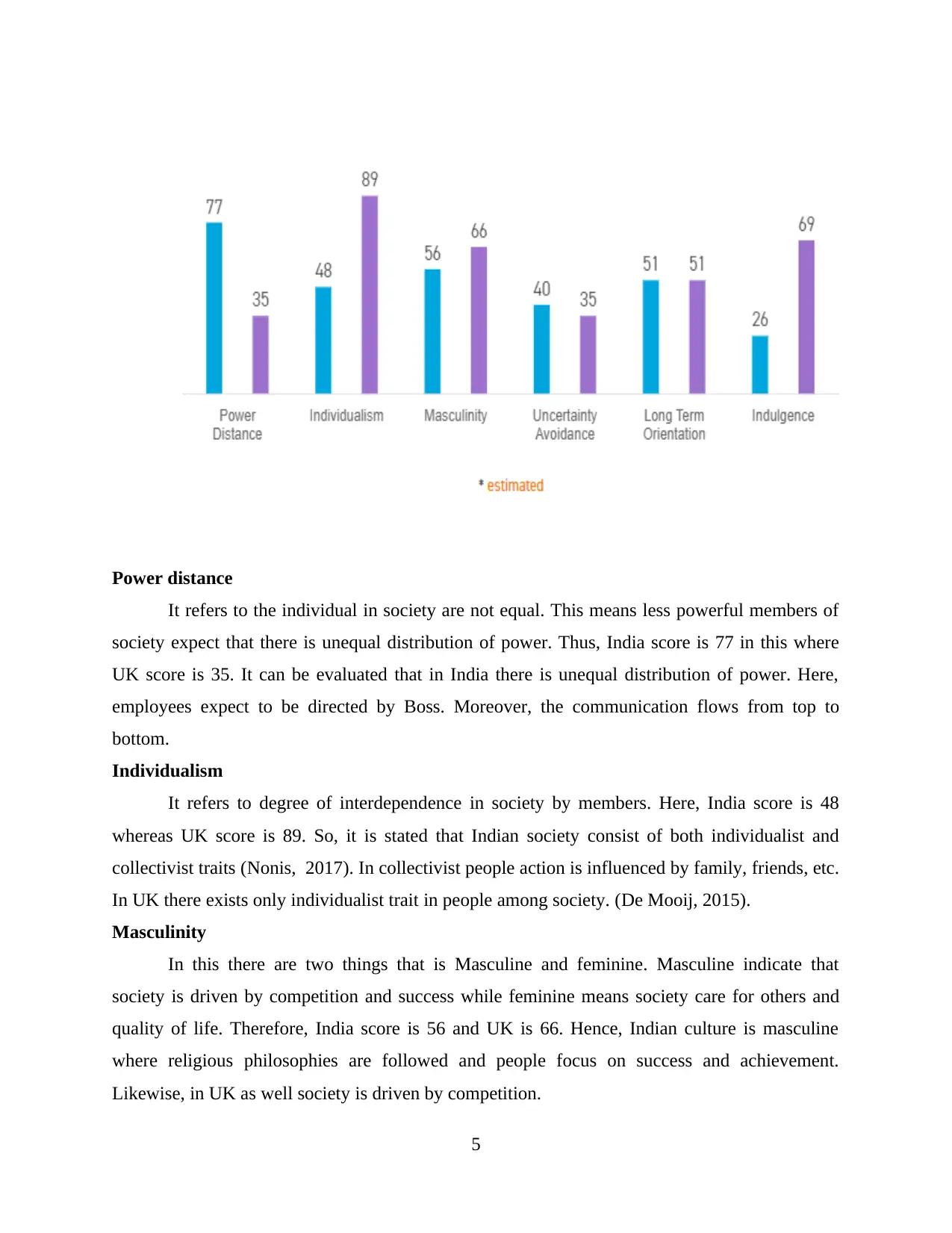
Power distance
It refers to the individual in society are not equal. This means less powerful members of
society expect that there is unequal distribution of power. Thus, India score is 77 in this where
UK score is 35. It can be evaluated that in India there is unequal distribution of power. Here,
employees expect to be directed by Boss. Moreover, the communication flows from top to
bottom.
Individualism
It refers to degree of interdependence in society by members. Here, India score is 48
whereas UK score is 89. So, it is stated that Indian society consist of both individualist and
collectivist traits (Nonis, 2017). In collectivist people action is influenced by family, friends, etc.
In UK there exists only individualist trait in people among society. (De Mooij, 2015).
Masculinity
In this there are two things that is Masculine and feminine. Masculine indicate that
society is driven by competition and success while feminine means society care for others and
quality of life. Therefore, India score is 56 and UK is 66. Hence, Indian culture is masculine
where religious philosophies are followed and people focus on success and achievement.
Likewise, in UK as well society is driven by competition.
5
It refers to the individual in society are not equal. This means less powerful members of
society expect that there is unequal distribution of power. Thus, India score is 77 in this where
UK score is 35. It can be evaluated that in India there is unequal distribution of power. Here,
employees expect to be directed by Boss. Moreover, the communication flows from top to
bottom.
Individualism
It refers to degree of interdependence in society by members. Here, India score is 48
whereas UK score is 89. So, it is stated that Indian society consist of both individualist and
collectivist traits (Nonis, 2017). In collectivist people action is influenced by family, friends, etc.
In UK there exists only individualist trait in people among society. (De Mooij, 2015).
Masculinity
In this there are two things that is Masculine and feminine. Masculine indicate that
society is driven by competition and success while feminine means society care for others and
quality of life. Therefore, India score is 56 and UK is 66. Hence, Indian culture is masculine
where religious philosophies are followed and people focus on success and achievement.
Likewise, in UK as well society is driven by competition.
5
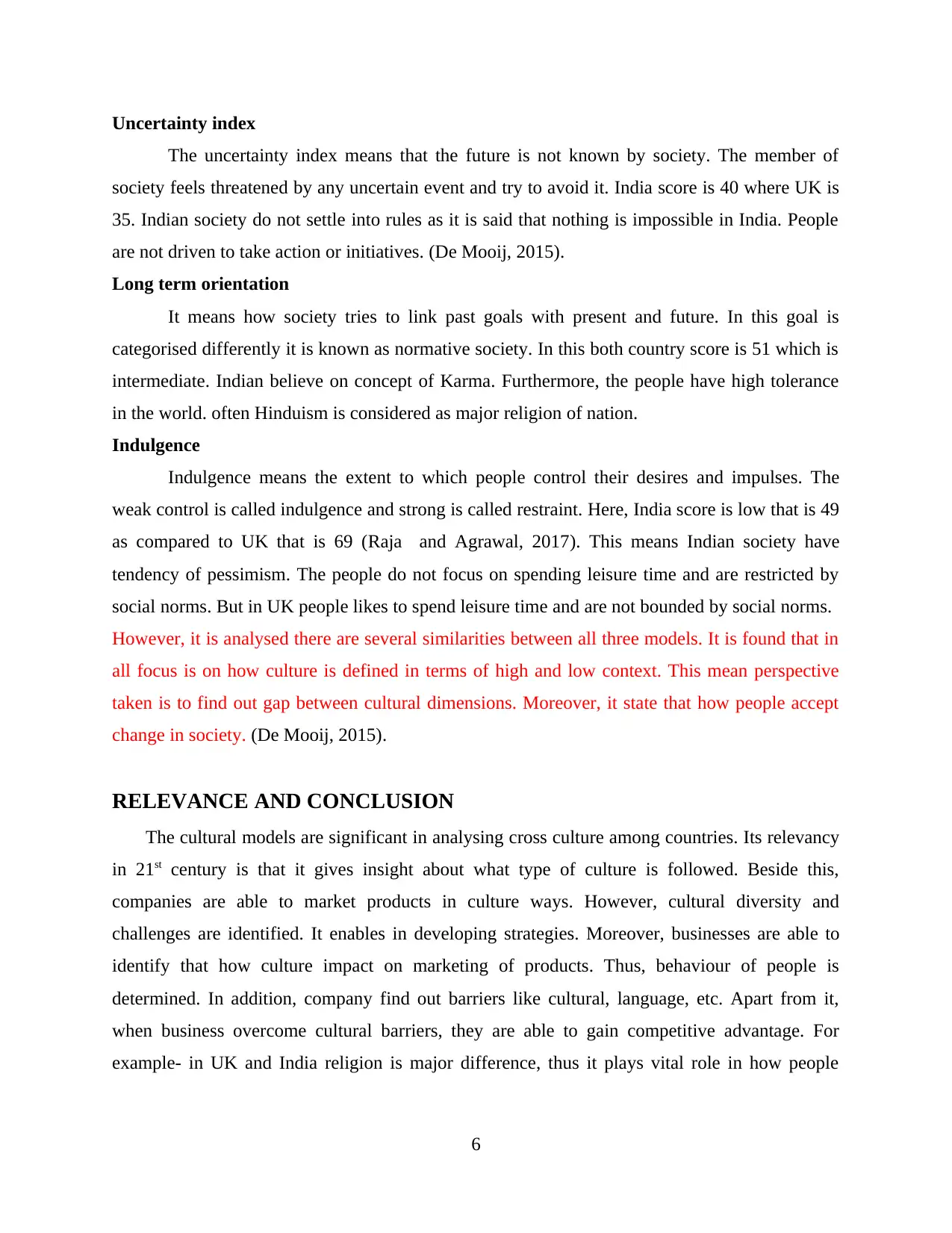
Uncertainty index
The uncertainty index means that the future is not known by society. The member of
society feels threatened by any uncertain event and try to avoid it. India score is 40 where UK is
35. Indian society do not settle into rules as it is said that nothing is impossible in India. People
are not driven to take action or initiatives. (De Mooij, 2015).
Long term orientation
It means how society tries to link past goals with present and future. In this goal is
categorised differently it is known as normative society. In this both country score is 51 which is
intermediate. Indian believe on concept of Karma. Furthermore, the people have high tolerance
in the world. often Hinduism is considered as major religion of nation.
Indulgence
Indulgence means the extent to which people control their desires and impulses. The
weak control is called indulgence and strong is called restraint. Here, India score is low that is 49
as compared to UK that is 69 (Raja and Agrawal, 2017). This means Indian society have
tendency of pessimism. The people do not focus on spending leisure time and are restricted by
social norms. But in UK people likes to spend leisure time and are not bounded by social norms.
However, it is analysed there are several similarities between all three models. It is found that in
all focus is on how culture is defined in terms of high and low context. This mean perspective
taken is to find out gap between cultural dimensions. Moreover, it state that how people accept
change in society. (De Mooij, 2015).
RELEVANCE AND CONCLUSION
The cultural models are significant in analysing cross culture among countries. Its relevancy
in 21st century is that it gives insight about what type of culture is followed. Beside this,
companies are able to market products in culture ways. However, cultural diversity and
challenges are identified. It enables in developing strategies. Moreover, businesses are able to
identify that how culture impact on marketing of products. Thus, behaviour of people is
determined. In addition, company find out barriers like cultural, language, etc. Apart from it,
when business overcome cultural barriers, they are able to gain competitive advantage. For
example- in UK and India religion is major difference, thus it plays vital role in how people
6
The uncertainty index means that the future is not known by society. The member of
society feels threatened by any uncertain event and try to avoid it. India score is 40 where UK is
35. Indian society do not settle into rules as it is said that nothing is impossible in India. People
are not driven to take action or initiatives. (De Mooij, 2015).
Long term orientation
It means how society tries to link past goals with present and future. In this goal is
categorised differently it is known as normative society. In this both country score is 51 which is
intermediate. Indian believe on concept of Karma. Furthermore, the people have high tolerance
in the world. often Hinduism is considered as major religion of nation.
Indulgence
Indulgence means the extent to which people control their desires and impulses. The
weak control is called indulgence and strong is called restraint. Here, India score is low that is 49
as compared to UK that is 69 (Raja and Agrawal, 2017). This means Indian society have
tendency of pessimism. The people do not focus on spending leisure time and are restricted by
social norms. But in UK people likes to spend leisure time and are not bounded by social norms.
However, it is analysed there are several similarities between all three models. It is found that in
all focus is on how culture is defined in terms of high and low context. This mean perspective
taken is to find out gap between cultural dimensions. Moreover, it state that how people accept
change in society. (De Mooij, 2015).
RELEVANCE AND CONCLUSION
The cultural models are significant in analysing cross culture among countries. Its relevancy
in 21st century is that it gives insight about what type of culture is followed. Beside this,
companies are able to market products in culture ways. However, cultural diversity and
challenges are identified. It enables in developing strategies. Moreover, businesses are able to
identify that how culture impact on marketing of products. Thus, behaviour of people is
determined. In addition, company find out barriers like cultural, language, etc. Apart from it,
when business overcome cultural barriers, they are able to gain competitive advantage. For
example- in UK and India religion is major difference, thus it plays vital role in how people
6
⊘ This is a preview!⊘
Do you want full access?
Subscribe today to unlock all pages.

Trusted by 1+ million students worldwide
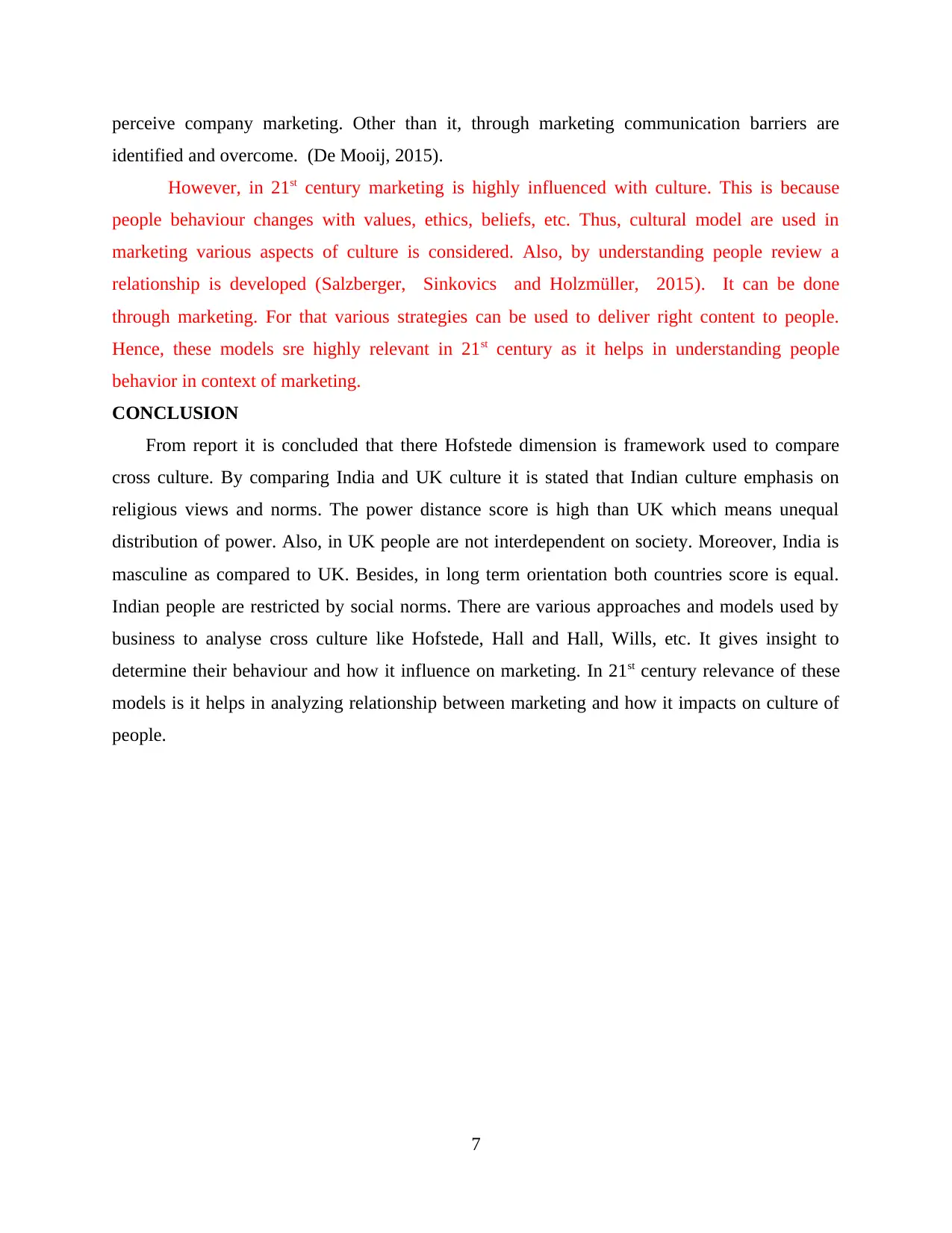
perceive company marketing. Other than it, through marketing communication barriers are
identified and overcome. (De Mooij, 2015).
However, in 21st century marketing is highly influenced with culture. This is because
people behaviour changes with values, ethics, beliefs, etc. Thus, cultural model are used in
marketing various aspects of culture is considered. Also, by understanding people review a
relationship is developed (Salzberger, Sinkovics and Holzmüller, 2015). It can be done
through marketing. For that various strategies can be used to deliver right content to people.
Hence, these models sre highly relevant in 21st century as it helps in understanding people
behavior in context of marketing.
CONCLUSION
From report it is concluded that there Hofstede dimension is framework used to compare
cross culture. By comparing India and UK culture it is stated that Indian culture emphasis on
religious views and norms. The power distance score is high than UK which means unequal
distribution of power. Also, in UK people are not interdependent on society. Moreover, India is
masculine as compared to UK. Besides, in long term orientation both countries score is equal.
Indian people are restricted by social norms. There are various approaches and models used by
business to analyse cross culture like Hofstede, Hall and Hall, Wills, etc. It gives insight to
determine their behaviour and how it influence on marketing. In 21st century relevance of these
models is it helps in analyzing relationship between marketing and how it impacts on culture of
people.
7
identified and overcome. (De Mooij, 2015).
However, in 21st century marketing is highly influenced with culture. This is because
people behaviour changes with values, ethics, beliefs, etc. Thus, cultural model are used in
marketing various aspects of culture is considered. Also, by understanding people review a
relationship is developed (Salzberger, Sinkovics and Holzmüller, 2015). It can be done
through marketing. For that various strategies can be used to deliver right content to people.
Hence, these models sre highly relevant in 21st century as it helps in understanding people
behavior in context of marketing.
CONCLUSION
From report it is concluded that there Hofstede dimension is framework used to compare
cross culture. By comparing India and UK culture it is stated that Indian culture emphasis on
religious views and norms. The power distance score is high than UK which means unequal
distribution of power. Also, in UK people are not interdependent on society. Moreover, India is
masculine as compared to UK. Besides, in long term orientation both countries score is equal.
Indian people are restricted by social norms. There are various approaches and models used by
business to analyse cross culture like Hofstede, Hall and Hall, Wills, etc. It gives insight to
determine their behaviour and how it influence on marketing. In 21st century relevance of these
models is it helps in analyzing relationship between marketing and how it impacts on culture of
people.
7
Paraphrase This Document
Need a fresh take? Get an instant paraphrase of this document with our AI Paraphraser
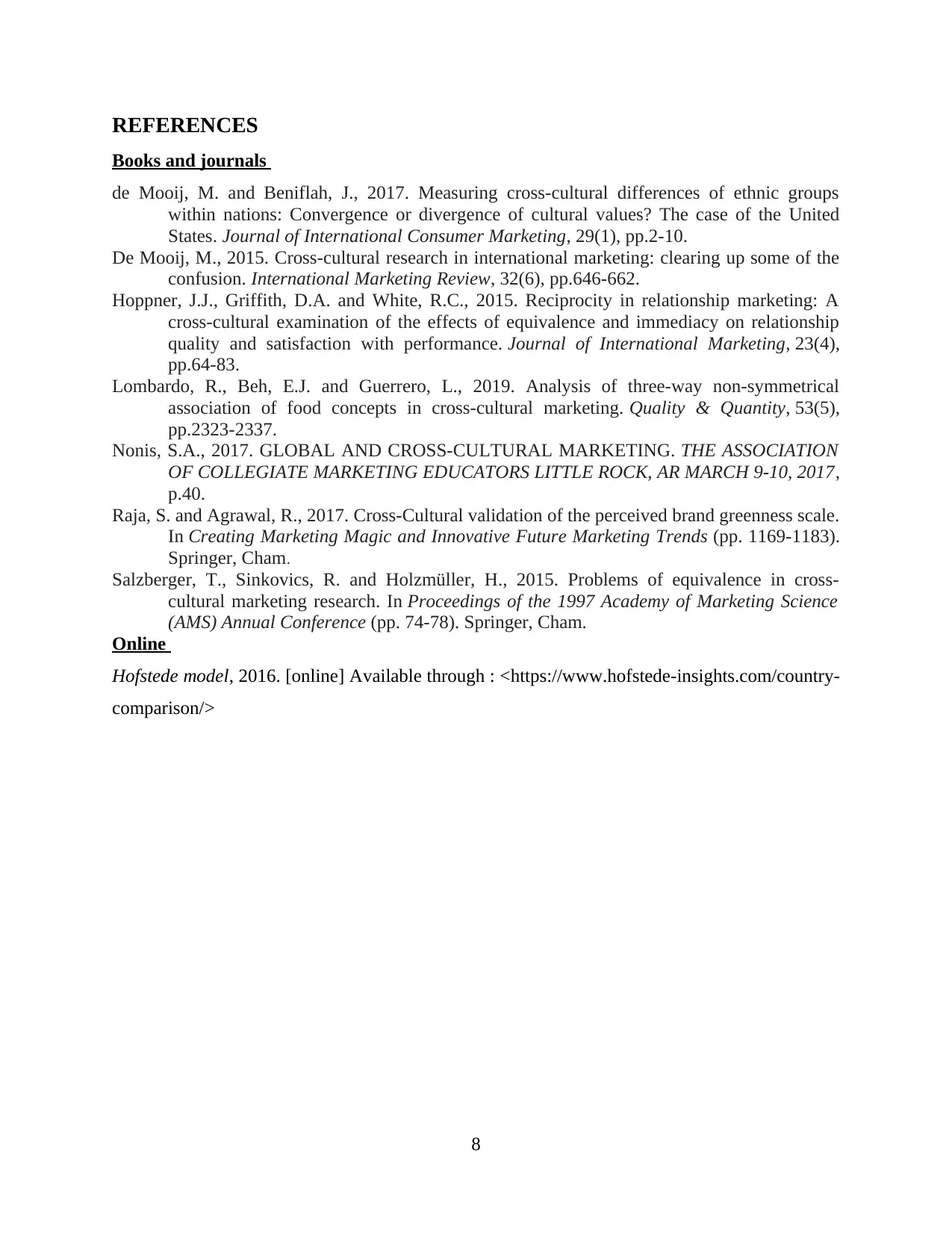
REFERENCES
Books and journals
de Mooij, M. and Beniflah, J., 2017. Measuring cross-cultural differences of ethnic groups
within nations: Convergence or divergence of cultural values? The case of the United
States. Journal of International Consumer Marketing, 29(1), pp.2-10.
De Mooij, M., 2015. Cross-cultural research in international marketing: clearing up some of the
confusion. International Marketing Review, 32(6), pp.646-662.
Hoppner, J.J., Griffith, D.A. and White, R.C., 2015. Reciprocity in relationship marketing: A
cross-cultural examination of the effects of equivalence and immediacy on relationship
quality and satisfaction with performance. Journal of International Marketing, 23(4),
pp.64-83.
Lombardo, R., Beh, E.J. and Guerrero, L., 2019. Analysis of three-way non-symmetrical
association of food concepts in cross-cultural marketing. Quality & Quantity, 53(5),
pp.2323-2337.
Nonis, S.A., 2017. GLOBAL AND CROSS-CULTURAL MARKETING. THE ASSOCIATION
OF COLLEGIATE MARKETING EDUCATORS LITTLE ROCK, AR MARCH 9-10, 2017,
p.40.
Raja, S. and Agrawal, R., 2017. Cross-Cultural validation of the perceived brand greenness scale.
In Creating Marketing Magic and Innovative Future Marketing Trends (pp. 1169-1183).
Springer, Cham.
Salzberger, T., Sinkovics, R. and Holzmüller, H., 2015. Problems of equivalence in cross-
cultural marketing research. In Proceedings of the 1997 Academy of Marketing Science
(AMS) Annual Conference (pp. 74-78). Springer, Cham.
Online
Hofstede model, 2016. [online] Available through : <https://www.hofstede-insights.com/country-
comparison/>
8
Books and journals
de Mooij, M. and Beniflah, J., 2017. Measuring cross-cultural differences of ethnic groups
within nations: Convergence or divergence of cultural values? The case of the United
States. Journal of International Consumer Marketing, 29(1), pp.2-10.
De Mooij, M., 2015. Cross-cultural research in international marketing: clearing up some of the
confusion. International Marketing Review, 32(6), pp.646-662.
Hoppner, J.J., Griffith, D.A. and White, R.C., 2015. Reciprocity in relationship marketing: A
cross-cultural examination of the effects of equivalence and immediacy on relationship
quality and satisfaction with performance. Journal of International Marketing, 23(4),
pp.64-83.
Lombardo, R., Beh, E.J. and Guerrero, L., 2019. Analysis of three-way non-symmetrical
association of food concepts in cross-cultural marketing. Quality & Quantity, 53(5),
pp.2323-2337.
Nonis, S.A., 2017. GLOBAL AND CROSS-CULTURAL MARKETING. THE ASSOCIATION
OF COLLEGIATE MARKETING EDUCATORS LITTLE ROCK, AR MARCH 9-10, 2017,
p.40.
Raja, S. and Agrawal, R., 2017. Cross-Cultural validation of the perceived brand greenness scale.
In Creating Marketing Magic and Innovative Future Marketing Trends (pp. 1169-1183).
Springer, Cham.
Salzberger, T., Sinkovics, R. and Holzmüller, H., 2015. Problems of equivalence in cross-
cultural marketing research. In Proceedings of the 1997 Academy of Marketing Science
(AMS) Annual Conference (pp. 74-78). Springer, Cham.
Online
Hofstede model, 2016. [online] Available through : <https://www.hofstede-insights.com/country-
comparison/>
8
1 out of 8
Related Documents
Your All-in-One AI-Powered Toolkit for Academic Success.
+13062052269
info@desklib.com
Available 24*7 on WhatsApp / Email
![[object Object]](/_next/static/media/star-bottom.7253800d.svg)
Unlock your academic potential
Copyright © 2020–2025 A2Z Services. All Rights Reserved. Developed and managed by ZUCOL.




